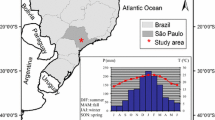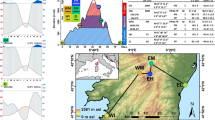Abstract
Climate sensitivity of populations at the margins of their distribution range is of key importance to understand species’ responses to future warming conditions. Pinus cembra is of particular interest being a typical high-elevation taxon, spread with mostly scattered populations within its actual range, but still overlooked in traditional dendrochronological researches due to low tree-ring variability and climate sensitivity. With a different approach, we analyzed time series of xylem anatomical traits, split into intra-ring sectors, and used daily climate records over 89 years (1926–2014) aiming to improve the quality and time resolution of the climate/growth associations. From nine trees growing at their altitudinal limit and on 1.5 × 106 tracheids, we measured ring width (MRW), cell number per ring, lumen area (LA), and cell-wall thickness (CWT). We then computed correlations with monthly and fortnightly climate data. Late-spring and summer temperature emerged as the most important factors. LA and especially CWT showed a stronger temperature response than MRW, starting in mid-May and early June, respectively. CWT also evidenced the longest period of correlations with temperature and a significant difference between latewood radial and tangential walls. Analysis of xylem anatomical traits at intra-ring level and the use of daily temperature records proved to be useful for high resolution and detailed climate/growth association inferences in Pinus cembra.






Similar content being viewed by others
References
Ali AA, Carcaillet C, Talon B, Roiron P, Terral J-F (2005) Pinus cembra L. (arolla pine), a common tree in the inner French Alps since the early Holocene and above the present tree line: a synthesis based on charcoal data from soils and travertines. J Biogeogr 32:1659–1669. https://doi.org/10.1111/j.1365-2699.2005.01308.x
Allen CD, Breshears DD, McDowell NG (2015) On underestimation of global vulnerability to tree mortality and forest die-off from hotter drought in the Anthropocene. Ecosphere 6:1–55. https://doi.org/10.1890/ES15-00203.1
Anderegg WRL, Schwalm C, Biondi F, Camarero JJ, Koch G, Litvak M, Ogle K, Shaw JD, Shevliakova E, Williams AP, Wolf A, Ziaco E, Pacala S (2015) Pervasive drought legacies in forest ecosystems and their implications for carbon cycle models. Science 349:528–532. https://doi.org/10.1126/science.aab1833
Babst F, Poulter B, Trouet V, Tan K, Neuwirth B, Wilson R, Carrer M, Grabner M, Tegel W, Levanic T, Panayotov M, Urbinati C, Bouriaud O, Ciais P, Frank D (2013) Site- and species-specific responses of forest growth to climate across the European continent. Glob Ecol Biogeogr 22:706–717. https://doi.org/10.1111/geb.12023
Babst F, Alexander MR, Szejner P, Bouriaud O, Klesse S, Roden J, Ciais P, Poulter B, Frank D, Moore DJP, Trouet V (2014) A tree-ring perspective on the terrestrial carbon cycle. Oecologia 176:307–322. https://doi.org/10.1007/s00442-014-3031-6
Brändström J (2001) Micro-and ultrastructural aspects of Norway spruce tracheids: a review. IAWA J 22:333–353
Buntgen U et al (2009) Three centuries of insect outbreaks across the European Alps. New Phytol 182:929–941. https://doi.org/10.1111/j.1469-8137.2009.02825.x
Carrer M, Urbinati C (2004) Age-dependent tree-ring growth responses to climate in Larix decidua and Pinus cembra. Ecology 85:730–740
Carrer M, Nola P, Eduard JL, Motta R, Urbinati C (2007) Regional variability of climate-growth relationships in Pinus cembra high elevation forests in the Alps. J Ecol 95:1072–1083. https://doi.org/10.1111/j.1365-2745.2007.01281.x
Carrer M, von Arx G, Castagneri D, Petit G (2015) Distilling allometric and environmental information from time series of conduit size: the standardization issue and its relationship to tree hydraulic architecture. Tree Physiol 35:27–33. https://doi.org/10.1093/treephys/tpu108
Carrer M, Brunetti M, Castagneri D (2016) The imprint of extreme climate events in century-long time series of wood anatomical traits in high-elevation conifers. Front Plant Sci 7. https://doi.org/10.3389/fpls.2016.00683
Carrer M, Castagneri D, Prendin AL, Petit G, von Arx G (2017) Retrospective analysis of wood anatomical traits reveals a recent extension in tree cambial activity in two high-elevation conifers. Front Plant Sci 8. https://doi.org/10.3389/fpls.2017.00737
Castagneri D, Petit G, Carrer M (2015) Divergent climate response on hydraulic-related xylem anatomical traits of Picea abies along a 900-m altitudinal gradient. Tree Physiol 35:1378–1387. https://doi.org/10.1093/treephys/tpv085
Castagneri D, Fonti P, von Arx G, Carrer M (2017) How does climate influence xylem morphogenesis over the growing season? Insights from long-term intra-ring anatomy in Picea abies. Ann Bot 119:1011–1020. https://doi.org/10.1093/aob/mcw274
Caudullo G, de Rigo D (2016) Pinus cembra in Europe: distribution, habitat, usage and threats. In: San-Miguel-Ayanz J, de Rigo D, Caudullo G, Houston Durrant T, Mauri A (eds) European Atlas of Forest Tree Species. Publ. Off. EU, Luxembourg, pp 120–121
Cook ER, Briffa K, Shiyatov S, Mazepa V (1990) Tree-ring standardization and growth-trend estimation. In: Cook ER, Kairiukstis LA (eds) Methods of Dendrochronology: Applications in the Environmental Sciences. Kluwer Academic Publisher, Dordrecht, The Netherlands, pp 104–123
Cuny HE, Rathgeber CBK, Frank D, Fonti P, Fournier M (2014) Kinetics of tracheid development explain conifer tree-ring structure. New Phytol 203:1231–1241. https://doi.org/10.1111/nph.12871
Dufour B, Morin H (2013) Climatic control of tracheid production of black spruce in dense mesic stands of eastern Canada. Tree Physiol 33:175–186. https://doi.org/10.1093/treephys/tps126
Efron B (1992) Bootstrap methods: another look at the jackknife. In: Kotz S, Johnson NL (eds) Breakthroughs in statistics: methodology and distribution. Springer New York, New York, NY, pp 569–593. https://doi.org/10.1007/978-1-4612-4380-9_41
Esper J, Büntgen U, Frank DC, Nievergelt D, Liebhold A (2007) 1200 years of regular outbreaks in alpine insects. Proc R Soc B 274:671–679
Fonti P, von Arx G, Garcia-Gonzalez I, Eilmann B, Sass-Klaassen U, Gartner H, Eckstein D (2010) Studying global change through investigation of the plastic responses of xylem anatomy in tree rings. New Phytol 185:42–53. https://doi.org/10.1111/j.1469-8137.2009.03030.x
Fonti P, Bryukhanova MV, Myglan VS, Kirdyanov AV, Naumova OV, Vaganov EA (2013) Temperature-induced responses of xylem structure of Larix sibirica (Pinaceae) from the Russian Altay. Am J Bot 100:1332–1343. https://doi.org/10.3732/ajb.1200484
Frank D, Esper J (2005) Characterization and climate response patterns of a high-elevation, multi-species tree-ring network in the European Alps. Dendrochronologia 22:107–121. https://doi.org/10.1016/j.dendro.2005.02.004
Frank DA, Reichstein M, Bahn M, Thonicke K, Frank D, Mahecha MD, Smith P, van der Velde M, Vicca S, Babst F, Beer C, Buchmann N, Canadell JG, Ciais P, Cramer W, Ibrom A, Miglietta F, Poulter B, Rammig A, Seneviratne SI, Walz A, Wattenbach M, Zavala MA, Zscheischler J (2015) Effects of climate extremes on the terrestrial carbon cycle: concepts, processes and potential future impacts. Glob Chang Biol 21:2861–2880. https://doi.org/10.1111/gcb.12916
Fritts HC (1976) Tree rings and climate. Academic Press, London
Guiot J (1991) The bootstrapped response function. Tree-Ring Bull 51:39–41
Hampe A, Petit RJ (2005) Conserving biodiversity under climate change: the rear edge matters. Ecol Lett 8:461–467. https://doi.org/10.1111/j.1461-0248.2005.00739.x
Hoch G, Popp M, Körner C (2002) Altitudinal increase of mobile carbon pools in Pinus cembra suggests sink limitation of growth at the Swiss treeline. Oikos 98:361–374
Holmes RL (1983) Computer-assisted quality control in tree-ring dating and measurement. Tree-Ring Bull 43:69–78
Huntley B (1990) European post-glacial forests: compositional changes in response to climatic change. J Veg Sci 1:507–518. https://doi.org/10.2307/3235785
IPCC (2013) Climate change 2013: the physical science basis. In: Stocker T et al (eds) Contribution of Working Group I to the Fifth Assessment Report of the Intergovernmental Panel on Climate Change. Cambridge Univ Press, Cambridge, p 1535
Jolliffe IT (2002) Principal component analysis. Springer, New York
Körner C (2012) Alpine Treelines: functional ecology of the global high elevation tree limits. Springer, Basel
Oberhuber W (2004) Influence of climate on radial growth of Pinus cembra within the alpine timberline ecotone. Tree Physiol 24:291–301. https://doi.org/10.1093/treephys/24.3.291
Olano JM, Arzac A, Garcia-Cervigon AI, von Arx G, Rozas V (2013) New star on the stage: amount of ray parenchyma in tree rings shows a link to climate. New Phytol 198:486–495. https://doi.org/10.1111/nph.12113
Pacheco A, Camarero JJ, Carrer M (2016) Linking wood anatomy and xylogenesis allows pinpointing of climate and drought influences on growth of coexisting conifers in continental Mediterranean climate. Tree Physiol 36:502–512. https://doi.org/10.1093/treephys/tpv125
Park A, Puettmann K, Wilson E, Messier C, Kames S, Dhar A (2014) Can boreal and temperate forest management be adapted to the uncertainties of 21st century climate change? Crit Rev Plant Sci 33:251–285. https://doi.org/10.1080/07352689.2014.858956
Parmesan C, Yohe G (2003) A globally coherent fingerprint of climate change impacts across natural systems. Nature 421:37–42. https://doi.org/10.1038/nature01286
Peres-Neto PR, Jackson DA, Somers KM (2005) How many principal components? Stopping rules for determining the number of non-trivial axes revisited. Comput Stat Data Anal 49:974–997. https://doi.org/10.1016/j.csda.2004.06.015
Petit G, Anfodillo T, Carraro V, Grani F, Carrer M (2011) Hydraulic constraints limit height growth in trees at high altitude. New Phytol 189:241–252. https://doi.org/10.1111/j.1469-8137.2010.03455.x
Prendin AL, Petit G, Carrer M, Fonti P, Björklund J, von Arx G (2017) New research perspectives from a novel approach to quantify tracheid wall thickness. Tree Physiol 37:976–983. https://doi.org/10.1093/treephys/tpx037
Reichstein M, Bahn M, Ciais P, Frank D, Mahecha MD, Seneviratne SI, Zscheischler J, Beer C, Buchmann N, Frank DC, Papale D, Rammig A, Smith P, Thonicke K, van der Velde M, Vicca S, Walz A, Wattenbach M (2013) Climate extremes and the carbon cycle. Nature 500:287–295. https://doi.org/10.1038/nature12350
Rosner S (2013) Hydraulic and biochemical optimization in Norway spruce trunkwood—a review. IAWA J 34:365–390. https://doi.org/10.1163/22941932-00000031
Rossi S, Deslauriers A, Anfodillo T (2006) Assessment of cambial activity and xylogenesis by microsampling tree species: an example at the alpine timberline. IAWA J 27:383–394
Rossi S, Deslauriers A, Anfodillo T, Carrer M (2008) Age-dependent xylogenesis in timberline conifers. New Phytol 177:199–208. https://doi.org/10.1111/j.1469-8137.2007.02235.x
Sánchez-Salguero R, Camarero JJ, Carrer M, Gutiérrez E, Alla AQ, Andreu-Hayles L, Hevia A, Koutavas A, Martínez-Sancho E, Nola P, Papadopoulos A, Pasho E, Toromani E, Carreira JA, Linares JC (2017) Climate extremes and predicted warming threaten Mediterranean Holocene firs forests refugia. Proc Natl Acad Sci U S A 114:E10142–E10150. https://doi.org/10.1073/pnas.1708109114
San-Miguel-Ayanz J et al. (2016) European atlas of forest tree species. Publications Office of the European Union. doi:citeulike-article-id:13984530 https://doi.org/10.2788/4251
Saulnier M, Edouard J-L, Corona C, Guibal F (2011) Climate/growth relationships in a Pinus cembra high-elevation network in the Southern French Alps. Ann For Sci 68:189–200. https://doi.org/10.1007/s13595-011-0020-3
Schweingruber FH, Johnson S (1993) Trees and wood in dendrochronology: morphological, anatomical, and tree-ring analytical characteristics of trees frequently used in dendrochronology. Springer, New York
Sirviö J, Kärenlampi P (1998) Pits as natural irregularities in softwood fibers. Wood Fiber Sci 30:27–39
Stokes MA, Smiley TL (1968) Introduction to tree-ring dating. University of Chicago Press, Chicago
Tranquillini W (1979) Physiological ecology of the alpine timberline. vol 31. Ecological studies. Springher-Verlag, Berlin
Vaganov EA, Hughes K, Shashkin AV (2006) Growth dynamics of conifer tree rings: images of past and future environments vol 183. Ecological Studies. Springer
Vittoz P, Rulence B, Largey T, Freléchoux F (2008) Effects of climate and land-use change on the establishment and growth of cembran pine (Pinus cembra L.) over the altitudinal treeline ecotone in the Central Swiss Alps. Arct Antarct Alp Res 40:225–232. https://doi.org/10.1657/1523-0430(06-010)[VITTOZ]2.0.CO;2
von Arx G, Carrer M (2014) ROXAS–a new tool to build centuries-long tracheid-lumen chronologies in conifers. Dendrochronologia 32:290–293. https://doi.org/10.1016/j.dendro.2013.12.001
von Arx G, Crivellaro A, Prendin AL, Cufar K, Carrer M (2016) Quantitative wood anatomy-practical guidelines. Front Plant Sci 7. https://doi.org/10.3389/fpls.2016.00781
Vysotskaya L, Vaganov E (1989) Components of the variability of radial cell size in tree rings of conifers. IAWA J 10:417–426
Xia J, Chen J, Piao S, Ciais P, Luo Y, Wan S (2014) Terrestrial carbon cycle affected by non-uniform climate warming. Nat Geosci 7:173–180. https://doi.org/10.1038/ngeo2093
Acknowledgments
We are very grateful to Maria Elena Gelain, Department of Comparative Biomedicine and Food Safety, University of Padova, for giving us access to the D-sight 2.0 System automatic scanner (Grandi Attrezzature Fund, University of Padova).
Author information
Authors and Affiliations
Corresponding author
Rights and permissions
About this article
Cite this article
Carrer, M., Unterholzner, L. & Castagneri, D. Wood anatomical traits highlight complex temperature influence on Pinus cembra at high elevation in the Eastern Alps. Int J Biometeorol 62, 1745–1753 (2018). https://doi.org/10.1007/s00484-018-1577-4
Received:
Revised:
Accepted:
Published:
Issue Date:
DOI: https://doi.org/10.1007/s00484-018-1577-4




